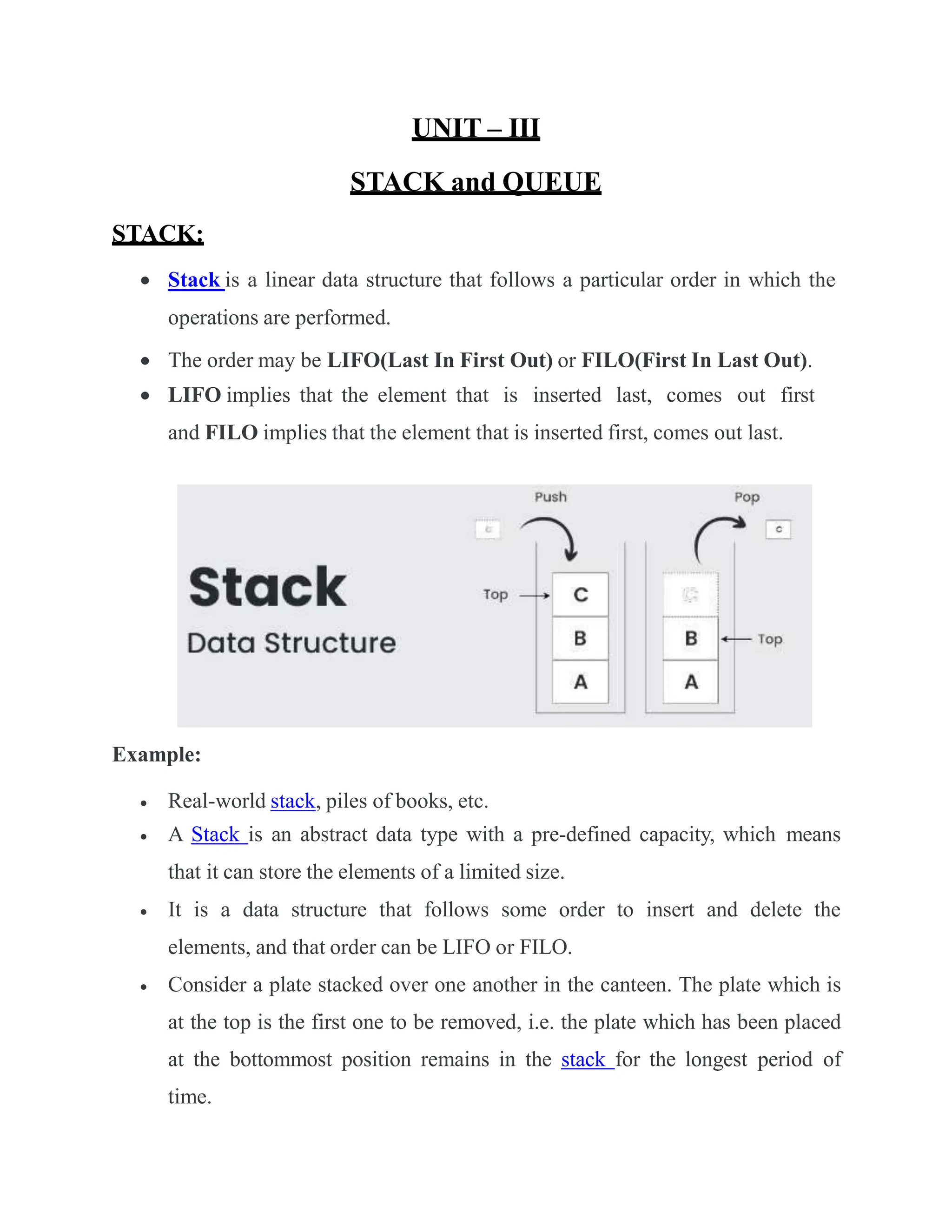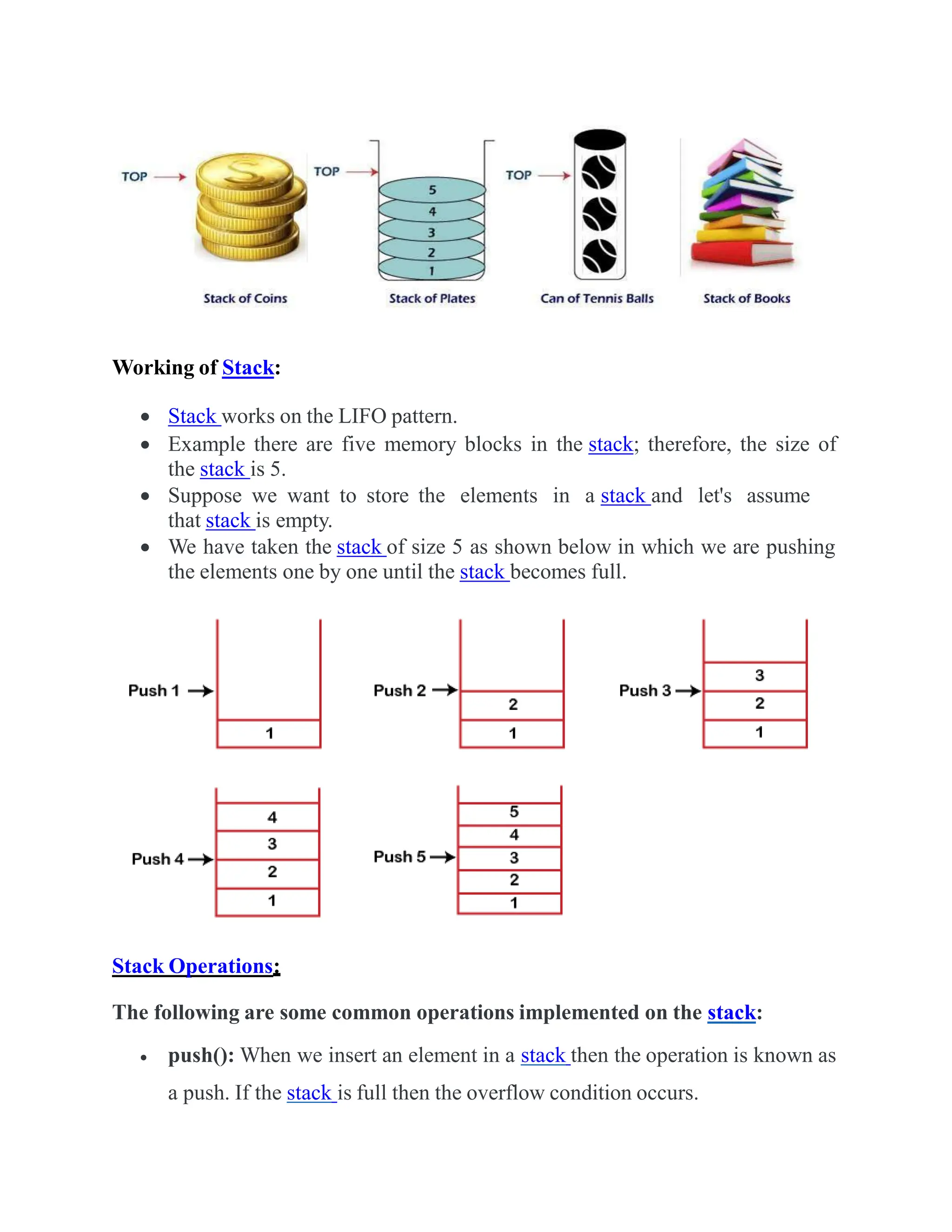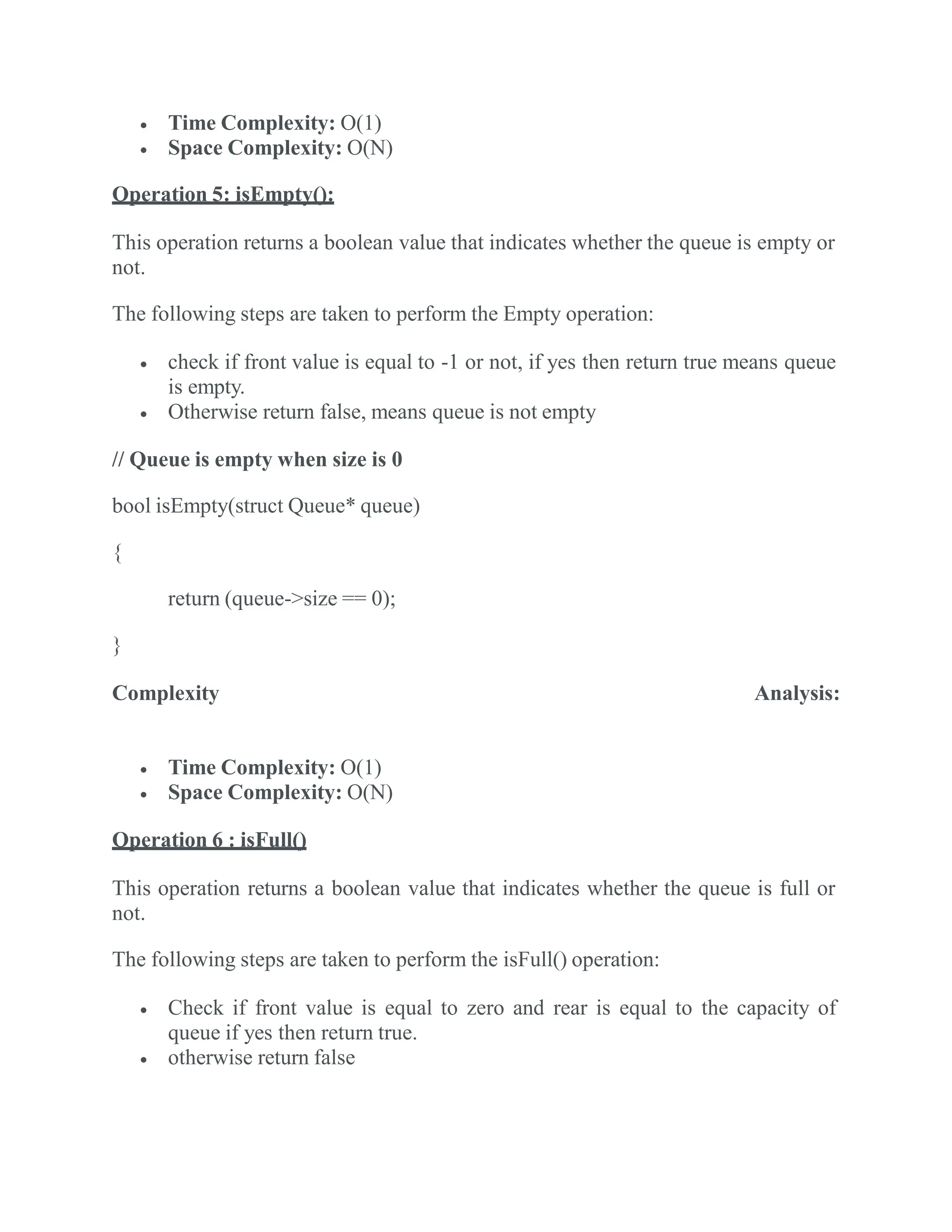This document covers stack and queue data structures, detailing their characteristics, operations, and implementations. A stack follows a Last In First Out (LIFO) principle while a queue operates on a First In First Out (FIFO) basis, with specific operations described for each. It includes various use cases and examples of executing and evaluating arithmetic expressions using stacks.








![Algorithm for STACK:
#include <stdio.h>
#include <stdlib.h>
#define MAX_SIZE 5
// Stack structure
typedef struct {
int items[MAX_SIZE];
int top;
} Stack;
// Function to initialize the stack
void init(Stack *stack) {
stack->top = -1;
}
// Function to check if the stack is full
int isFull(Stack *stack) {
return stack->top == MAX_SIZE - 1;
}
// Function to check if the stack is empty
int isEmpty(Stack *stack) {
return stack->top == -1;
}
// Function to push an element onto the stack
void push(Stack *stack, int value) {
if (isFull(stack)) {
printf("Stack is fulln");](https://image.slidesharecdn.com/dsunitiiic-240514041827-9189ca7b/75/Stack-and-its-operations-Queue-and-its-operations-9-2048.jpg)
![return;
}
stack->top++;
stack->items[stack->top] = value;
printf("Pushed %dn", value);
}
// Function to pop an element from the stack
int pop(Stack *stack) {
int item;
if (isEmpty(stack)) {
printf("Stack is emptyn");
return -1;
}
item = stack->items[stack->top];
stack->top--;
return item;
}
// Function to peek at the top element of the stack
int peek(Stack *stack) {
if (isEmpty(stack)) {
printf("Stack is emptyn");
return -1;
}
return stack->items[stack->top];
}](https://image.slidesharecdn.com/dsunitiiic-240514041827-9189ca7b/75/Stack-and-its-operations-Queue-and-its-operations-10-2048.jpg)




![// Function to add an item to the queue.
// It changes rear and size
void enqueue(struct Queue* queue, int item)
{
if (isFull(queue))
return;
queue->rear = (queue->rear + 1) % queue->capacity;
queue->array[queue->rear] = item;
queue->size = queue->size + 1;
printf("%d enqueued to queuen", item);
}](https://image.slidesharecdn.com/dsunitiiic-240514041827-9189ca7b/75/Stack-and-its-operations-Queue-and-its-operations-15-2048.jpg)

![// Function to remove an item from queue.
// It changes front and size
int dequeue(struct Queue* queue)
{
if (isEmpty(queue)) {
printf("nQueue is emptyn");
return;
}
int item = queue->array[queue->front];
queue->front = (queue->front + 1) % queue->capacity;
queue->size = queue->size - 1;
return item;
}
Complexity Analysis:
Time Complexity: O(1)
Space Complexity: O(N)
Operation 3: front()
This operation returns the element at the front end without removing it.
The following steps are taken to perform the front operation:
If the queue is empty return the most minimum value.
otherwise, return the front value.
// Function to get front of queue](https://image.slidesharecdn.com/dsunitiiic-240514041827-9189ca7b/75/Stack-and-its-operations-Queue-and-its-operations-17-2048.jpg)
![int front(struct Queue* queue)
{
if (isempty(queue))
return INT_MIN;
return queue->arr[queue->front];
}
Complexity Analysis:
Time Complexity: O(1)
Space Complexity: O(N)
Operation 4 : rear()
This operation returns the element at the rear end without removing it.
The following steps are taken to perform the rear operation:
If the queue is empty return the most minimum value.
otherwise, return the rear value.
// Function to get rear of queue
int front(struct Queue* queue)
{
if (isempty(queue))
return INT_MIN;
return queue->arr[queue->rear];
}
Complexity Analysis:](https://image.slidesharecdn.com/dsunitiiic-240514041827-9189ca7b/75/Stack-and-its-operations-Queue-and-its-operations-18-2048.jpg)



![ The major drawback of using a linear Queue is that insertion is done only
from the rear end.
If the first three elements are deleted from the Queue, we cannot insert more
elements even though the space is available in a Linear Queue.
In this case, the linear Queue shows the overflow condition as the rear is
pointing to the last element of the Queue.
Algorithm for Linear Queue:
#include <stdio.h>
#include <stdlib.h>
#define MAX_SIZE 5
// Linear Queue structure
typedef struct {
int items[MAX_SIZE];
int front, rear;
} LinearQueue;
// Function to initialize the linear queue
void init(LinearQueue *queue) {
queue->front = -1;
queue->rear = -1;
}
// Function to check if the queue is full
int isFull(LinearQueue *queue) {](https://image.slidesharecdn.com/dsunitiiic-240514041827-9189ca7b/75/Stack-and-its-operations-Queue-and-its-operations-22-2048.jpg)
![return queue->rear == MAX_SIZE - 1;
}
// Function to check if the queue is empty
int isEmpty(LinearQueue *queue) {
return queue->front == -1;
}
// Function to add an element to the queue
void enqueue(LinearQueue *queue, int value) {
if (isFull(queue)) {
printf("Queue is fulln");
return;
}
if (isEmpty(queue)) {
queue->front = 0;
}
queue->rear++;
queue->items[queue->rear] = value;
printf("Inserted %dn", value);
}
// Function to remove an element from the queue
int dequeue(LinearQueue *queue) {](https://image.slidesharecdn.com/dsunitiiic-240514041827-9189ca7b/75/Stack-and-its-operations-Queue-and-its-operations-23-2048.jpg)
![int item;
if (isEmpty(queue)) {
printf("Queue is emptyn");
return -1;
}
item = queue->items[queue->front];
if (queue->front == queue->rear) {
queue->front = -1;
queue->rear = -1;
} else {
queue->front++;
}
return item;
}
// Function to display the elements of the queue
void display(LinearQueue *queue) {
if (isEmpty(queue)) {
printf("Queue is emptyn");
return;
}
printf("Front -> ");](https://image.slidesharecdn.com/dsunitiiic-240514041827-9189ca7b/75/Stack-and-its-operations-Queue-and-its-operations-24-2048.jpg)
![for (int i = queue->front; i <= queue->rear; i++) {
printf("%d -> ", queue->items[i]);
}
printf("Rearn");
}
int main() {
LinearQueue queue;
init(&queue);
enqueue(&queue, 1);
enqueue(&queue, 2);
enqueue(&queue, 3);
enqueue(&queue, 4);
enqueue(&queue, 5);
enqueue(&queue, 6); // Queue is full
display(&queue); // Output: 1 -> 2 -> 3 -> 4 -> 5 -> Rear
printf("Deleted element: %dn", dequeue(&queue));
printf("Deleted element: %dn", dequeue(&queue));
display(&queue); // Output: 3 -> 4 -> 5 -> Rear
enqueue(&queue, 6);
display(&queue); // Output: 3 -> 4 -> 5 -> 6 -> Rear
return 0; }](https://image.slidesharecdn.com/dsunitiiic-240514041827-9189ca7b/75/Stack-and-its-operations-Queue-and-its-operations-25-2048.jpg)




![Algorithm of Circular Queue:
#include <stdio.h>
#include <stdlib.h>
#define MAX_SIZE 5
// Circular Queue structure
typedef struct {
int items[MAX_SIZE];
int front, rear;
} CircularQueue;
// Function to initialize the circular queue
void init(CircularQueue *queue) {
queue->front = -1;
queue->rear = -1;
}
// Function to check if the queue is full
int isFull(CircularQueue *queue) {
return (queue->front == 0 && queue->rear == MAX_SIZE - 1) || (queue->rear
== (queue->front - 1) % (MAX_SIZE - 1));
}
// Function to check if the queue is empty
int isEmpty(CircularQueue *queue) {
return queue->front == -1;
}
// Function to add an element to the queue
void enqueue(CircularQueue *queue, int value) {
if (isFull(queue)) {](https://image.slidesharecdn.com/dsunitiiic-240514041827-9189ca7b/75/Stack-and-its-operations-Queue-and-its-operations-30-2048.jpg)
![printf("Queue is fulln");
return;
}
if (isEmpty(queue)) {
queue->front = 0;
queue->rear = 0;
} else {
queue->rear = (queue->rear + 1) % MAX_SIZE;
}
queue->items[queue->rear] = value;
printf("Inserted %dn", value);
}
// Function to remove an element from the queue
int dequeue(CircularQueue *queue) {
int item;
if (isEmpty(queue)) {
printf("Queue is emptyn");
return -1;
}
if (queue->front == queue->rear) {
item = queue->items[queue->front];
queue->front = -1;
queue->rear = -1;
} else {
item = queue->items[queue->front];](https://image.slidesharecdn.com/dsunitiiic-240514041827-9189ca7b/75/Stack-and-its-operations-Queue-and-its-operations-31-2048.jpg)
![queue->front = (queue->front + 1) % MAX_SIZE;
}
return item;
}
// Function to display the elements of the queue
void display(CircularQueue *queue) {
if (isEmpty(queue)) {
printf("Queue is emptyn");
return;
}
printf("Front -> ");
for (int i = queue->front; i != queue->rear; i = (i + 1) % MAX_SIZE) {
printf("%d -> ", queue->items[i]);
}
printf("%d -> Rearn", queue->items[queue->rear]);
}
int main() {
CircularQueue queue;
init(&queue);
enqueue(&queue, 1);
enqueue(&queue, 2);
enqueue(&queue, 3);
enqueue(&queue, 4);
enqueue(&queue, 5);
enqueue(&queue, 6); // Queue is full](https://image.slidesharecdn.com/dsunitiiic-240514041827-9189ca7b/75/Stack-and-its-operations-Queue-and-its-operations-32-2048.jpg)
